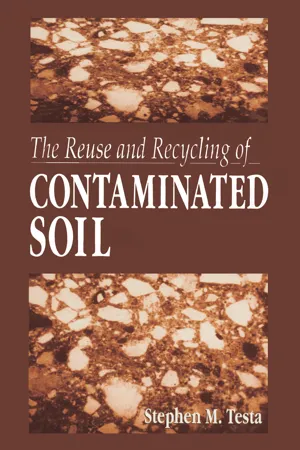Technology & Engineering
Bituminous Materials
Bituminous materials are a group of substances derived from crude oil and used in various engineering applications. They are commonly used in road construction and roofing due to their waterproofing and adhesive properties. Bituminous materials can be in the form of asphalt, tar, or bitumen, and their composition and properties can be modified to suit specific applications.
Written by Perlego with AI-assistance
Related key terms
1 of 5
12 Key excerpts on "Bituminous Materials"
- eBook - ePub
Materials in Construction
An Introduction
- G. D. Taylor(Author)
- 2013(Publication Date)
- Routledge(Publisher)
11 Bituminous Materials DOI: 10.4324/9781315839158-11Chapter summary
- Types of bitumen and road tar.
- Principles of design of pavements.
- Asphalts and macadams.
- Surface dressings.
- Defects in bituminous pavements or surfacings.
- Bituminous products for roofing.
11.1 Introduction
General usage of the term ‘bituminous’ covers products based on tar as well as those based on bitumen, though bitumen-based products are more widely employed in all forms of construction. The bituminous group of materials offers the following general attractions:- Excellent resistance to absorption/passage of water.
- Good adhesion to many materials.
- Resistance to dilute acids and alkalis.
- Good flexibility at normal temperatures.
- Properties can be varied to suit application.
- They tend to become brittle at low temperatures and soft at high temperatures.
- They are subject to creep.
- They have low inherent stiffness and so must be carefully blended with harder materials where stresses are encountered.
The enviornmental considerations for Bituminous Materials are given in Table 11.1 .Table 11.1 Environmental considerations: Bituminous MaterialsConsideration Assessment Raw material availability Manufactured from oil, or lake asphalt — limited supplies Extraction No specific problems Energy used in manufacture Moderately high chemical energy required Health/safety hazards Oil transportation carries risks; vapours can be harmful Recyclability Possible in large-scale applications such as roads 11.2 Bitumen (BS 3690)
The larger molecular weight fractions are of solid nature and these are dispersed in the lower molecular weight fractions which are either of a resinous or an oily nature.Bitumen consists essentially of hydrocarbons of varying molecular size which are soluble in carbon disulphide.Bitumens occur naturally in the form of asphalts, which are mixtures of bitumen, minerals and water found in the form of rock or lake asphalt. The majority of bitumen is, however, produced as a residue from the fractional distillation of crude oil. - eBook - PDF
Construction Materials, Methods, and Techniques
Building for a Sustainable Future
- Eva Kultermann, William Spence, Eva Kultermann(Authors)
- 2021(Publication Date)
- Cengage Learning EMEA(Publisher)
Bituminous Materials L E A R N I N G O B J E C T I V E S Upon completion of this chapter, the student should be able to: ● Describe the properties of bitumen and how these properties influence decisions as to how Bituminous Materials might be used. ● Interpret the results of laboratory tests and use these for decision making. ● Be familiar with the array of bituminous products available and their applications. 26 Bitumen is a mixture of organic liquids made of complex hydrocarbons that occur naturally or are heat-produced from materials like coal and wood (Figure 26.1). Highly viscous, black, and sticky bitumens exist in gaseous, liquid, semisolid, or solid states. Bitumen can be made from non-petroleum-based renew- able resources, such as sugar, molasses, and rice, corn and potato starches. Bitumen can also be made from waste mate- rial through fractional distillation of used motor oils, which are otherwise disposed of by burning or dumping into landfills. Non-petroleum-based bitumen binders can be made lighter in color. Roads made with lighter-colored pitch absorb less heat from solar radiation and stay cooler than darker surfaces, reducing their contribution to the urban heat island effect. Asphalt, tar, and coal tar pitch are the most commonly used Bituminous Materials in construction. Asphalt is found in natural deposits or produced from petroleum. Tar is produced by the distillation of wood and coal. Fractional distillation of tar produces coal tar pitch. PROPERTIES OF BITUMENS Perhaps the most significant property of bitumens is their excel- lent water resistance. A variety of different bitumen products are produced as waterproof materials. Bitumens bond well to dry solid surfaces because they exist in the semi-fluid state needed by adhesives to bond. They will not bond to wet surfaces. Bitumens are flammable and will ignite when heated to their flashpoint. This influences the temperatures used to heat Bituminous Materials for various applications. - eBook - ePub
- David Doran, Bob Cather, David Doran, Bob Cather(Authors)
- 2013(Publication Date)
- Routledge(Publisher)
34Bituminous MaterialsGeoffrey Griffiths FICE, FIATAssociate Director UK Infrastructure, ArupRobert Langridge BSc MIATAsphalt Quality Advisory ServiceBob Cather BSc CEng FIMMMConsultant, formerly Director of Arup Materials ConsultingDavid Doran FCGI BSc(Eng) DIC CEng FICE FIStructEConsultant, formerly Chief Engineer with Wimpey plcContents
34.1 History and background34.2 Bituminous Materials: Types and definitions34.3 Modified bitumens34.3.1 Cut-back and fluxed bitumen34.3.2 Bitumen emulsions34.4 Classification of bitumens34.4.1 Oxidised bitumen34.5 Health and safety34.6 Environmental impact of bitumens34.7 Further technical advice34.8 Bituminous Materials in building applications34.8.1 Roofing and waterproofing34.8.2 Below-ground waterproofing34.8.3 Flooring34.8.4 Protection coatings34.8.5 Joint sealants34.9 Bituminous Materials in trafficked pavements34.9.1 The basic pavement structure34.9.2 Design methods34.9.3 Standard specifications34.9.4 Typical pavement types34.9.5 Types of material34.9.6 Materials definitions and testing methods34.9.7 Manufacture34.9.8 Failures and construction problems34.9.9 Pavement management systems (PMS)34.10 Further information and references34.1 History and backgroundBitumen is one of the oldest known engineering materials and has been used from the earliest times as an adhesive, sealant and waterproofing agent. As long ago as 6000 BC, ship-builders in Sumeria used naturally occurring bitumen found in surface seepages in the area.In the Indus valley, now in Pakistan, there is a well-preserved water tank that dates back to around 3000 BC. The stone blocks in the walls of the tank are bonded with naturally sourced bitumen and there is a vertical bituminous core in the centre of the wall. This principle is still used today in the design of dams and other water-retaining structures. It is believed that Nebuchadnezzar was one of the early exponents of bitumen, as there is evidence that he used the material for water-proofing the masonry in the construction of Babylon and as grout for stone roads. - eBook - ePub
- Jamal Khatib(Author)
- 2016(Publication Date)
- Woodhead Publishing(Publisher)
14Sustainability of Bituminous Materials
I. Widyatmoko AECOM, Nottingham, United KingdomAbstract
Bituminous Materials are one of the oldest and most widely used construction materials. While their components are obtained from finite resources, these materials have long been known as sustainable products due to their capacity to extend their serviceable lives through reclaim, reuse and/or the recycling processes. This chapter presents holistic aspects on the sustainability of Bituminous Materials, including their sources, processes, productions, standards, designs, good practices, and preservative maintenance. Future trends and challenges are also presented at the end of this chapter, highlighting opportunities and works to be done to accelerate implementation of the latest technologies which preserve the use of Bituminous Materials, while at the same time promoting the longevity of these materials in service. These works would also require closer collaboration between the industry and authorities to update regulations and approval systems.Keywords
Bitumen; Rheology; Performance; Durability; Recycle; Preservative maintenance; Low temperature asphalt.14.1 Introduction to Bituminous Materials
Bituminous Materials, also known as asphalt mixtures, are amongst the oldest engineering materials. Their use as binding and waterproofing materials can be dated back to 3000 BC, and later the Romans developed roads in many parts of their empire, marking the first global use of bituminous binders in road paving technology. Eurobitume (2015) reported that over 90% of all the roads in Europe are surfaced with Bituminous Materials.Bituminous Materials (asphalts) typically comprise three major constituents: aggregates (80–95%), filler (2–8%) and bituminous binders (3–7%); additives are sometimes used to enhance the properties of the mixture. Aggregates and fillers are the predominant constituents of bituminous mixtures and provide a skeleton which contributes to the stability to the mixture. - eBook - ePub
Construction Materials
Their Nature and Behaviour, Fifth Edition
- Marios Soutsos, Peter Domone, Marios Soutsos, Peter Domone(Authors)
- 2017(Publication Date)
- CRC Press(Publisher)
Part IX Bituminous Materials Gordon D. Airey IntroductionThe term ‘Bituminous Materials’ is generally taken to include all materials consisting of aggregate bound with bitumen. Materials of this kind are used almost exclusively in road construction. However, bitumen is also used for industrial applications and other forms of construction. For example, bitumen is used in roofing materials, paints, carpet tiles and as a protective/waterproof coating. This part will concentrate on the use of Bituminous Materials in road construction.Prior to the use of bitumen, tar was the binder used in Bituminous Materials. The use of tar in road building materials began to grow significantly in the United Kingdom just after the turn of the century following the advent of the pneumatic tyre and the motor vehicle. Up to that time, roads were constructed following the principles developed by MacAdam using water-bound, graded aggregate. Under the action of pneumatic tyres and the higher speeds of motor vehicles, a great deal of dust was generated on macadam roads, which led to the use of tar as a dressing to bind the surface. Tar was eminently suitable for this purpose since it could be made sufficiently fluid by the use of heat to be sprayed, but stiffened on cooling. Furthermore, it protected the road from the detrimental effects of water. The benefits of using tar were quickly realised, and a range of ‘coated stone’ materials, or ‘tarmacadams’, were developed.References to natural sources of bitumen date back to biblical times. However, the first use of natural rock asphalt for paving roads was in the middle of the nineteenth century. The first refinery bitumens to be used in the United Kingdom came from the Mexican oilfields around 1913. But it was the opening of the Shell Haven refinery in 1920 that gave rise to the rapid development of bitumen for road construction. Bitumen was found to be less temperature susceptible than tar. Thus, it was harder or stiffer than an equivalent grade of tar at high temperatures, making it more resistant to deformation, and softer than tar at low temperatures, making it less brittle and more resistant to cracking. As the quantity and weight of traffic increased, the performance required of Bituminous Materials increased and bitumen became more widely used than tar. Although tar-bound materials predominated during the Second World War due to difficulties in importing crude oil, the introduction of North Sea gas in the late 1960s dramatically reduced the production of crude coal tar. In addition, the carcinogenic nature of tar made it an unacceptable binder in Bituminous Materials. Therefore, the following chapters will deal only with bitumen. - CHAPTER 5 Materials used in road pavements M.J. Brennan and C.A. O'Flaherty All road pavements require the efficient use of locally available materials if economically constructed roads are to be built. This requires the design engineer to have a thorough understanding of not only the soil and aggregate properties that affect pavement stability and durability but also the properties of the binding materials that may be added to these. The most important pavement materials are bitumen and tar, cement and lime, soil (see Chapter 4), and rock, gravel and slag aggregates. In more recent years, for economic and environmental reasons, renewed attention has been given to the use of 'waste' materials in lieu of conventional aggregates in pavements so these are discussed here also. 5.1 Penetration-grade refinery bitumens Bitumens used for road construction are viscous liquid or semi-solid materials, consisting essentially of hydrocarbons and their derivatives, which are soluble in trichloroethylene 1 . Whilst bitumens occur naturally (e.g. in lake asphalts containing mineral materials), the predominant majority of those used in roadworks are the penetration-grade products of the fractional distillation of petroleum at refineries. It might be noted here that the term 'asphalt' is used in the American technical literature to describe what is termed 'bitumen' in the UK. In the UK (and in Europe, following agreement by the Comite Europeen de Normalisation) the term `asphalt' is reserved for materials containing a mixture of bitumen and mineral matter, e.g. lake asphalt or hot rolled asphalt. Bitumens that are produced artificially from petroleum crudes (usually napthenic-and asphaltic-base crudes) are known as refinery bitumens. Not all petroleum crudes are suitable for the production of road bitumen; those used in the UK are mainly derived from Middle East and South American sources, as most of the North Sea crudes contain little or no bitumen.
- eBook - ePub
Roadwork
Theory and Practice
- Malcolm Copson, Peter Kendrick, Steve Beresford(Authors)
- 2019(Publication Date)
- CRC Press(Publisher)
When a range of aggregates is available, the aggregates having the better physical properties are naturally preferred for use in the surface course of all the more heavily trafficked roads. ‘Good’ stone is, however, so limited in the quantity available, that it should not be used in situations where a poorer quality stone would suffice.10.4 Bitumen
10.4.1 Derivation
Bitumen is understood to be‘a viscous liquid or solid material, black or brown in colour, having adhesive qualities, consisting essentially of hydrocarbons, derived from petroleum or occurring in natural asphalt and soluble in carbon disulphide’.The major proportion of road bitumen used in this country is derived from petroleum by a refinery distillation process. This is sometimes referred to as residual bitumen or as straight-run bitumen.This usually consists of a rather porous limestone, or more rarely sandstone, naturally impregnated with bitumen with approximate proportions of 90% stone, 10% bitumen. It is now normally used only in mastic asphalt which is an expensive surfacing and, therefore, used only to a limited extent. See BS 1446 for more information about mastic asphalt. Blending of different rocks may be necessary to obtain the desired binder material.10.4.2 Rock Asphalt
10.4.3 Lake Asphalt
This is a naturally occurring asphalt in which the mineral matter is finely divided and dispersed through the bitumen which is the major constituent. The whole mass is capable of flowing. Trinidad Lake asphalt is the only type used in roadmaking in Britain, being used, when suitably fluxed, mainly in rolled asphalt surface courses.10.5 Sources of Refinery Bitumen
Bitumen, produced by industrial refining of crude oil, is known as ‘residual’ bitumen, ‘straight-run’ bitumen or ‘steam-refined’ bitumen. The term ‘refinery bitumen’ is, however, the most descriptive and appropriate.Bitumen is produced from selected crude oils by the distillation of petroleum. The distillate is obtained by first heating to about 350°C under atmospheric pressure to drive off light fractions, e.g. gasoline, kerosene and gas oil. - eBook - PDF
Highway Engineering
Pavements, Materials and Control of Quality
- Athanassios Nikolaides(Author)
- 2014(Publication Date)
- CRC Press(Publisher)
3.1.1 Terminology today At this stage, in order to avoid confusion, it is necessary to clarify the meaning of the terms bitumen and asphalt , as well as their adjectives bituminous and bituminous binder. The rea-son is that, nowadays, the above terms have different meanings, certainly among European and American specifications and practising engineers. In Europe and according to CEN EN 12597 (2000), bitumen is virtually an involatile, adhesive and waterproofing material derived from crude petroleum or present in natural asphalt, which is completely or almost completely soluble in toluene and very viscous or almost solid at ambient temperatures. According to the same specification, asphalt is a mixture of mineral aggregate and bitu-minous binder. In addition, bituminous is the adjective applicable to binders and mixtures of binders and aggregates containing bitumen. Hence, bituminous binder is the adhesive material contain-ing bitumen. Furthermore, natural asphalt is a relatively hard bitumen found in natural deposits, often mixed with fine or very fine mineral matter, which is virtually solid at 25°C and viscous fluid at 175°C at the same time. In American English and according to American specifications, more often the term asphalt is used rather than the term bitumen . According to ASTM D 8 (2013), ‘asphalt’ or ‘bitumen’ is ‘a dark brown to black cement-like residuum obtained from the distillation of suitable crude oils’. Another term also used in North America is asphalt cement , which has the same meaning as asphalt. The term asphalt binder has been utilised in the Superpave mix design method to classify the grade of asphalt cement used in an asphalt mix based on expected performance under specific environmental conditions and anticipated traffic loading. Asphalt binder according to ASTM D 8 (2013) is ‘an asphalt which may or may not contain an asphalt modifier’. - eBook - PDF
- Stephen M. Testa(Author)
- 2019(Publication Date)
- CRC Press(Publisher)
CHEMICAL ASPECTS OF BITUMENS AND ASPHALT 123 obtained as residual material through distillation in the refinery process. The Egyptians used bitumens, derived from the Latin term "pix tumens," meaning "tomb's pitch," from the Black Sea for the embalming of corpses. The word bitumen comes from the original Sanskrit word Gwitu-men, meaning pitch. More specifically, ASTM defines bitumen as mixtures of hydrocarbons of natural or pyrogenous origin, or combinations of both, frequently accompanied by their nonmetallic derivatives, which may be gaseous, liquid, semisolid or solid, and which are completely soluble in carbon disulfide. Bitumens are composed principally of high molecular weight hydrocarbons, such as asphalts, tars, pitches, and asphaltites. Pyrobitumen is a generic term for a dark colored, comparatively hard and nonvolatile, native substance composed of hydrocarbons. Such substances may or may not contain oxygenated bodies, sometimes associated with mineral water. The nonmineral constituents are infusible and relatively insoluble in carbon disulfide. This definition also applies to asphaltic and nonasphaltic pyrobitumens, and their respective shales. Bitumen is organic material consisting of quite variable mixtures of mainly aliphatic and aromatic hydrocarbons, combined in part with nitrogen, sulfur, and oxygen, of high molecular weight. Analysis usually consists of determining molecular weights, general nature of compounds, and elemental composition, rather than specific chemical structure. Bitumens derived from natural deposits resemble those derived from the distillation of petroleum, although natural bitumens often contain minerals, whereas those derived from refineries generally have more paraffinic side-chains than natural bitumens. Crude oils can contain up to 50% bitumens. Mineral wax refers to a species of bitumen and to certain pyrogenous substances. - eBook - PDF
Roadwork
Theory and Practice
- Malcolm Copson, Peter Kendrick, Steve Beresford(Authors)
- 2019(Publication Date)
- Routledge(Publisher)
193 1 Materials and testing 10 Materials: Flexible Pavements Volume 2 of the Specification for Highway Works, Notes for Guidance (SHW NG) contains advice in the use, specification, and testing of all materials and should be referred to. Use of materials to the specification should be used wherever possible. Table 1/1 in the 100 Series of Volume 2 of SHW (NG) outlines the testing requirements for many different types of materials. Currently all British Standards are being revised to meet European Standards. Readers will need to be aware of new BSEN Standards. 10.1 Bituminous Roadbuilding Materials All bituminous road surfacings are composed mainly of aggregate, which may be crushed natural rock, slag or gravel with sand or stone fines. The aggregate plays an important part in the behaviour of the surfacing. Many aggregates have sufficient mechanical strength to be used for roadmaking, even in the surface course which has to carry the direct traffic load, but the majority of these, however, tend to polish under heavy traffic, which causes the surface to become slippery and unsuitable for traffic use. The shape of the particles may also limit the usefulness of an aggregate for roadmaking. If the material is produced by crushing, a considerable degree of control of the shape is possible. Aggregate from even a single source can vary considerably and frequent checks of quality must be made to maintain a consistent supply of road material. Although the proportion of bituminous binder in surfacing is much less than that of the aggregate, the quantity and quality of the binder has a marked effect on the behaviour of the surfacing. Bituminous binders are of two main types. These are: 1 tar (which is a product of the carbonization process). Tar products are now considered a Class 1 carcinogen. Where a pavement is being planed it is important to recognise that any tar-bound materials, including old surface dressings, should be considered as hazardous. - eBook - PDF
- James G. Speight(Author)
- 2014(Publication Date)
- CRC Press(Publisher)
However, the term pyrobitumen does not convey the impression intended; thus, the members of this class are referred to as asphaltoids since they closely resemble the asphaltites. Pyrobitumen is a naturally occurring solid organic substance that is distinguishable from bitu-men ( q.v .) by being infusible and insoluble. When heated, however, pyrobitumen generates, or trans-form into, bitumen-like liquid and gaseous hydrocarbon compounds. Pyrobitumen may be either asphaltic or nonasphaltic. The asphaltic pyrobitumens are derived from petroleum, are relatively hard, and have a specific gravity below 1.25. They do not melt when heated but swell and decom-pose ( intumesce ). There is much confusion regarding the classification of asphaltoids, although four types are recognized, elaterite , wurtzilite , albertite , and impsonite, in order of increasing density and fixed carbon content. In fact, it is doubtful that the asphaltoid group can ever be clearly differentiated from the asphaltites. It is even more doubtful that the present subdivisions will ever have any real meaning, nor is it clear that the materials have any necessary genetic connection. Again, caution should be exercised in the use of the names, and due care should be applied to qualification of the particular sample. 1.4.9 B ITUMINOUS R OCK AND B ITUMINOUS S AND Bituminous rock and bituminous sand (see also bitumen , page 17) are those formations in which the bituminous material is found as a filling in veins and fissures in fractured rocks or impregnat-ing relatively shallow sand, sandstone, and limestone strata. The deposits contain as much as 20% bituminous material, and if the organic material in the rock matrix is bitumen, it is usual (although chemically incorrect) to refer to the deposit as rock asphalt to distinguish it from bitumen that is relatively mineral free. - V.S. Ramachandran, Ralph M. Paroli, James J. Beaudoin, Ana H. Delgado(Authors)
- 2002(Publication Date)
- William Andrew(Publisher)
The roofing contractors predicted that the low-slope roofing market would be 63.3% in the year 2001. Most types of roofing materials are bituminous and synthetic (polymeric) roofing membranes. The most commonly used roofing and waterproofing membrane is made by combining asphalt or coal tar pitch (bitumen) with felts or mats, or fabrics of organic or inorganic fibers. 2.0 BITUMINOUS ROOFING MATERIAL The built-up roof membrane consists of bitumen, reinforced with roofing felts, and aggregates which protect the bitumen from the UV radiation and oxidation. Bituminous Materials have been used since 3500 BC. Because of their waterproofing, preservative, and binder characteris-tics, they were utilized by the ancients for the construction of houses and roads. [4] Bituminous Materials were also used by ancient civilizations such as Egyptians for construction, mummification, waterproofing, preserva-tives, and binders. Type 1993 [2] 2000 [3] New New construction Re-roofing construction Re-roofing Built-up roofing 29.0% 31.0% 22.4% 27.8% Single ply roofing 38.8% 33.3% 38.1% 33.6% Modified bitumen 17.0% 21.7% 19.1% 23.8% Metal 3.5% 1.6% 4.3% 2.5% Other types * 11.7% 12.4% 16.1% 12.3% * Other types = tiles, PUF, liquid-applied, asphalt shingles, metal 613 The asphalt is a complex mixture of organic and inorganic com-pounds and their complexes. Some of the organic compounds are aliphatics, aromatics, polar aromatics, and asphaltenes. Polar aromatics are respon-sible for the viscoelastic properties of asphalts. [5] Over the years, multilayers of tar-based waterproofers replaced the hot asphalt used in roofing. In early 1900, asphalt became available from petroleum refining, and it was followed by oxidized bitumen interlaid with roofing felt and then alternated with a mineral base sheet.
Index pages curate the most relevant extracts from our library of academic textbooks. They’ve been created using an in-house natural language model (NLM), each adding context and meaning to key research topics.











